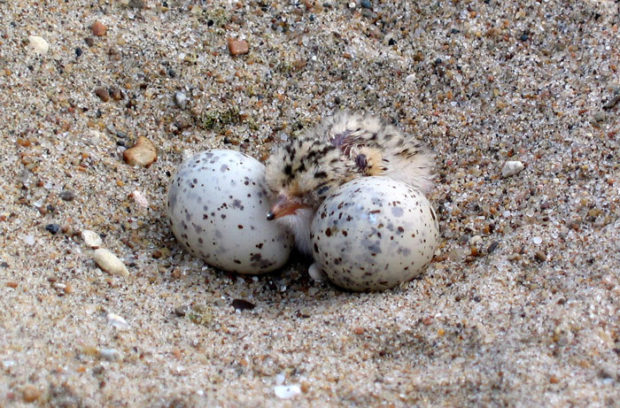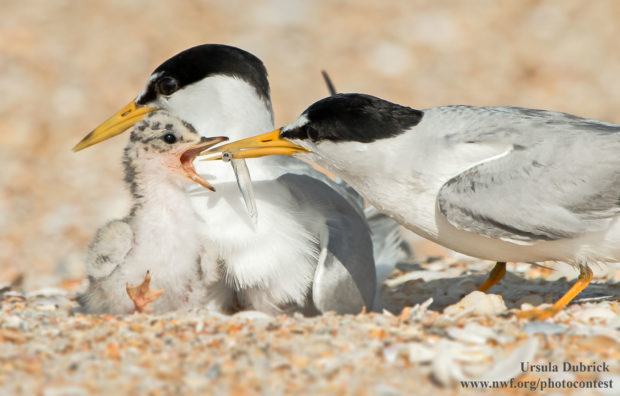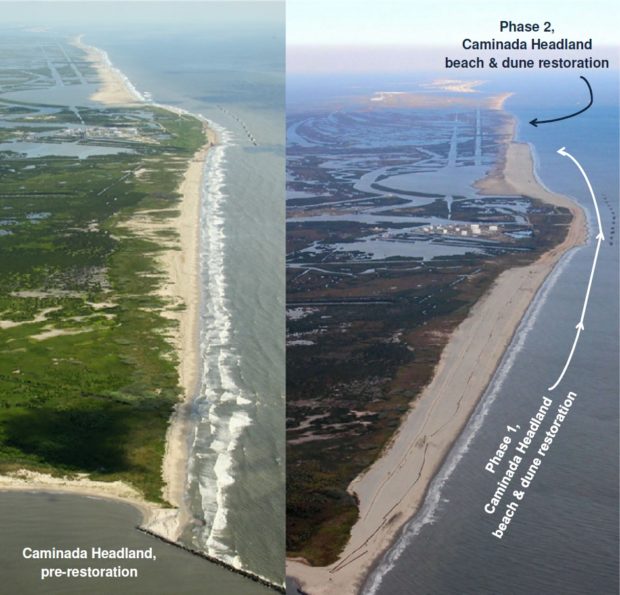We have much more to do and your continued support is needed now more than ever.
Least Terns: Life on the Edge
Least terns live life on the edge. Only nine inches long and packing just 1.5 ounces of muscle and feather, they are aptly named. Despite their size, they are prodigious migrants—heading south in August and September to the coast of northern South America, returning to breed in late April.

Even without the pressure of condos, beachgoers, four-wheelers, and unleashed dogs, beaches are tough places to raise a chick. The beach habitat they prefer itself prefers to be green—plants insist on colonizing it, rendering it unfit for the tern nests. So they choose some of the lower beaches, either on the coast or on interior sand bars along rivers, the ones that don’t flood every day or every week, but that flood often enough that the scour keeps the sand clear of vegetation.
The trick for them is to time nesting for when the averages are in their favor. On the Gulf Coast that means after the last cold fronts have passed and before the first tropical storms arrive. With luck that gives them almost four months, from late April when Pacific and Arctic fronts stop reaching the coast, into August, when tropical storm activity picks up.
But luck is not always on the tern’s side. If their nests wash out, they will re-nest up to three times in a given summer, but each delay makes the likelihood that the chicks will be ready and strong enough to fly south that much more tenuous.

Louisiana’s beaches are in deep trouble—decades of canal dredging and jetty building have interrupted the natural systems that used to feed sand to the islands. The source of the sand, the Mississippi River, has been cut off by three centuries of levee building, channelization of the passes for navigation, and damming of the former distributary channels. The barrier islands and headlands are starved of sand, sinking and shrinking, now mere wisps of their former selves. The remaining beaches are low, getting lower, and subject to frequent over-wash.

National Wildlife Federation, the Louisiana Wildlife Federation, and the Restore the Mississippi River Delta Campaign are strong advocates for the Coastal Master Plan, and we’ve pushed hard for a resolution of the BP Deepwater Horizon disaster that sends crucial dollars to Gulf restoration.
With money from Louisiana’s share of offshore oil and gas revenue, and from the BP 2012 criminal settlement, the work is underway. And this summer we saw a concrete example of how it can make a difference for least terns. The depression that would eventually become Tropical Storm Bill, the one that sent record floods to Texas and Oklahoma, began to track across the Gulf in mid-June. Southeast Louisiana saw no storm winds, torrential rains or surge, but the plight of much of the coast is now such that even a disturbance in the Gulf hundreds of miles away is enough to send tides and waves crashing over the tern colonies, wiping out the eggs and chicks.
On the Caminada Headland, a broad arc of sand fronting the marshes and bays of Bayou Lafourche, the state is pumping sand barged from Ship Shoal, raising the beach and dune system high enough to withstand these minor tide events. Even while the project was underway, least terns were nesting. Where the new sand was in place the nests survived. Just miles away on Elmer’s Island, which has not yet been nourished by new sand, the nests washed away. This is a tangible restoration success on both the grand landscape scale, and on the small scale for one tiny species of threatened wildlife.

![]() Join us in the fight to restore the Gulf of Mexico for least terns and other wildlife!
Join us in the fight to restore the Gulf of Mexico for least terns and other wildlife!





















